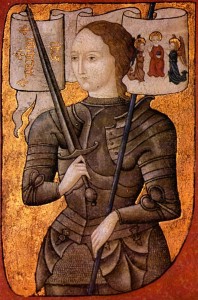Jeanne d’Arc’s captors moved her about France. Eventually she was sold by the Duke of Burgundy to the English and they brought her to Rouen, the capital of the English controlled Duchy of Normandy.
Rouen was one of the most prosperous cities in medieval Europe and it is a fascinating city to visit. Although extensively bombed during the Second World War, the city center offers many half-timbered buildings of traditional Normandy design, medieval churches, and the actual location of Jeanne’s execution.
03d Execution of Jeanne d’Arc in Rouen
Département: Seine-Maritime
Region: Haute-Normandie
Country: France
A French Battlefields “Virtual Battlefield Tour” [This battlefield is not included in Fields of War.]
Summary: Jeanne d’Arc was bought from the Duke of Burgundy by the English ruler of occupied France, John Lancaster, Duke of Bedford. She was brought to Rouen on Christmas Day 1430 and imprisoned in the Château Bouvreuil built by Philip Augustus in 1205. After a lengthy trial, she was found guilty of heresy. On 30 May 1431 she was burned at the stake in the place du Vieux-Marché and her ashes were scattered in the Seine River.
View Execution of Jeanne d’Arc in Rouen- A Virtual Battlefield Tour by French Battlefields (www.frenchbattlefields.com) in a larger map


